Avoid infecting your device via "Quotation Request" spam emails
Phishing/ScamAlso Known As: "Quotation Request" malspam
Get free scan and check if your device is infected.
Remove it nowTo use full-featured product, you have to purchase a license for Combo Cleaner. Seven days free trial available. Combo Cleaner is owned and operated by RCS LT, the parent company of PCRisk.com.
What kind of email is "Quotation Request"?
Upon examination, we determined that "Quotation Request" is malspam. This email is presented as a potential purchase inquiry. The goal is to deceive recipients into opening the malicious attachment and infecting their devices with the Agent Tesla malware.
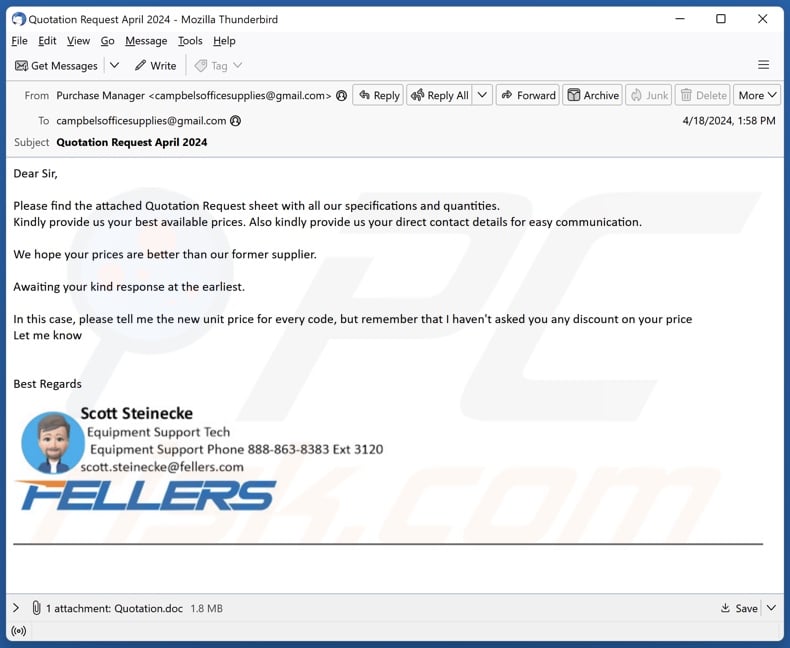
"Quotation Request" email virus overview
The spam email with the subject "Quotation Request April 2024" (may vary) asks the recipient to review the attached document. It contains a quote request that details specifications and quantities. The recipient is requested to provide the best available price and direct contact information.
It must be stressed that this business proposal is fake, and it is not associated with any legitimate entities.
The file attached to this email – "Quotation.doc" (filename may vary) – is infectious. When it is opened and the macro commands (i.e., editing/content) are enabled, the download/installation of Agent Tesla RAT (Remote Access Trojan) is triggered. RATs are designed to give remote access/control over devices, and Agent Tesla has significant data-stealing functionalities.
In summary, victims of spam mail like "Quotation Request" can experience system infections, severe privacy issues, financial losses, and even identity theft.
If you suspect that your device is already infected – perform a complete system scan with an anti-virus and eliminate all detected threats.
| Name | "Quotation Request" malspam |
| Threat Type | Malspam, Malicious Spam |
| Fake Claim | Recipient is requested to provide best prices for the potential purchase detailed in the attachment. |
| Attachment(s) | Quotation.doc (filename may vary) |
| Detection Names | Avast (RTF:CVE-2017-11882-A [Expl]), Combo Cleaner (Exploit.RTF-ObfsObjDat.Gen), ESET-NOD32 (Win32/Exploit.CVE-2017-11882.BLZ), Kaspersky (UDS:DangerousObject.Multi.Generic), Microsoft (Exploit:O97M/CVE-2017-11882.SMK!MTB), Full List Of Detections (VirusTotal) |
| Payload | Agent Tesla |
| Symptoms | Trojans are designed to stealthily infiltrate the victim's computer and remain silent, and thus no particular symptoms are clearly visible on an infected machine. |
| Distribution methods | Infected email attachments, malicious online advertisements, social engineering, software 'cracks'. |
| Damage | Stolen passwords and banking information, identity theft, the victim's computer added to a botnet. |
| Malware Removal (Windows) |
To eliminate possible malware infections, scan your computer with legitimate antivirus software. Our security researchers recommend using Combo Cleaner. Download Combo CleanerTo use full-featured product, you have to purchase a license for Combo Cleaner. 7 days free trial available. Combo Cleaner is owned and operated by RCS LT, the parent company of PCRisk.com. |
Malspam campaign examples
"Confirm Hotel Bank Account", "Rooming List For The Group", "Order List", "MINISTÉRIO PUBLICO PORTUGAL", and "Missing Invoice" are merely a few examples of malspam we have written about recently.
Spam emails are used to proliferate a wide variety of malware, such as trojans, ransomware, cryptominers, etc. Various scams like phishing, sextortion, refund, tech support, inheritance, lottery, and others are promoted through these emails.
However, regardless of what these messages claim or promise, their end goal is the same – to generate revenue for cyber criminals.
How do spam campaigns infect computers?
Malware is commonly proliferated via spam campaigns. Deceptive emails/messages can have infectious files attached to or linked inside them. In the case of "Quotation Request", the attachment is a Microsoft Word document.
Opening an infectious file triggers the malware download/installation process. Some formats require additional actions, e.g., Microsoft Office files need users to enable macro commands (i.e., editing/content).
However, virulent files can be in other formats, e.g., archives (ZIP, RAR, etc.), executables (.exe, .run, etc.), documents (Microsoft OneNote, PDF, etc.), JavaScript, and so on.
How to avoid installation of malware?
We strongly recommend treating incoming emails, PMs/DMs, SMSes, and other messages with caution. It is important to use Microsoft Office versions released after 2010 since they have the "Protected View" mode that prevents automatic macro command execution.
However, malware is spread using other methods as well. Therefore, we advise being careful while browsing, as fake and dangerous online content usually appears genuine and harmless.
Another recommendation is to download only from official and verified channels. Additionally, all programs must be activated and updated using legitimate functions/tools, as illegal activation tools ("cracks") and third-party updaters can contain malware.
We must emphasize the importance of having a reputable anti-virus installed and kept up-to-date. Security software must be used to run regular system scans and to remove detected threats and issues. If you've already opened malicious attachments, we recommend running a scan with Combo Cleaner Antivirus for Windows to automatically eliminate infiltrated malware.
Text presented in the "Quotation Request" email letter:
Subject: Quotation Request April 2024
Dear Sir,
Please find the attached Quotation Request sheet with all our specifications and quantities.
Kindly provide us your best available prices. Also kindly provide us your direct contact details for easy communication.
We hope your prices are better than our former supplier.
Awaiting your kind response at the earliest.
In this case, please tell me the new unit price for every code, but remember that I haven't asked you any discount on your price
Let me know
Best Regards
Screenshot of the malicious attachment distributed via "Quotation Request" spam campaign ("Quotation.doc"):
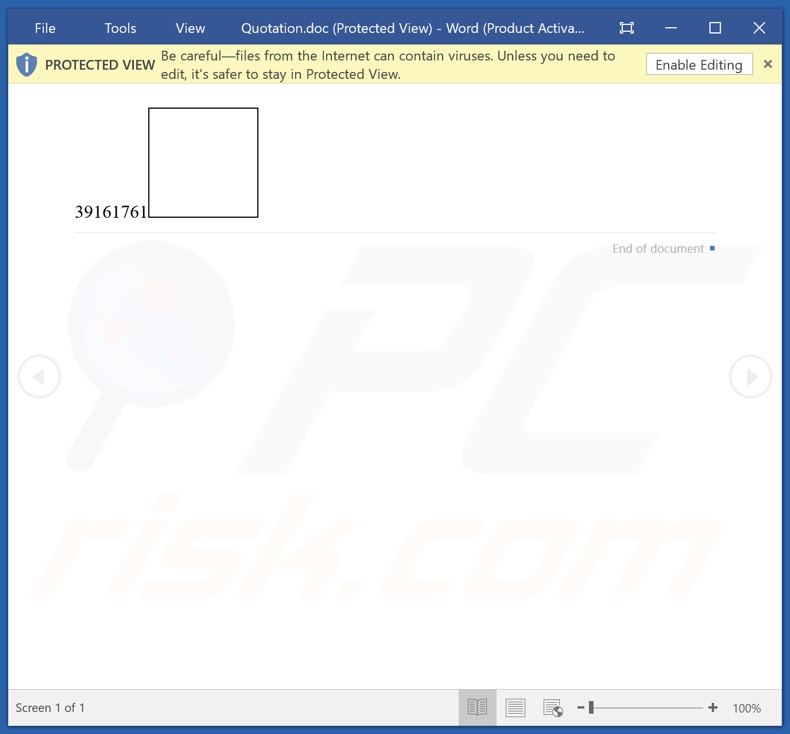
An example of quotation request-themed spam email promoting a phishing site:
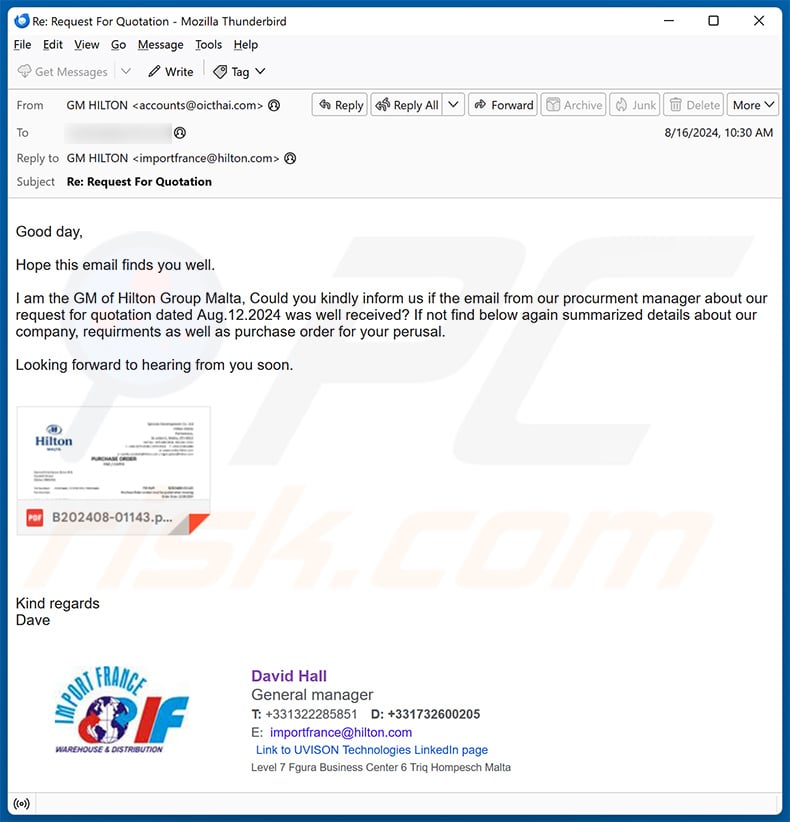
Text presented within:
Subject: Re: Request For Quotation
Good day,Hope this email finds you well.
I am the GM of Hilton Group Malta, Could you kindly inform us if the email from our procurment manager about our request for quotation dated Aug.12.2024 was well received? If not find below again summarized details about our company, requirments as well as purchase order for your perusal.
Looking forward to hearing from you soon.
Kind regards
Dave
David Hall
General manager
T: +331322285851
D: +331732600205
E: importfrance@hilton.comLink to UVISON Technologies LinkedIn page
Level 7 Fgura Business Center 6 Triq Hompesch Malta
Screenshot of the promoted phishing site:
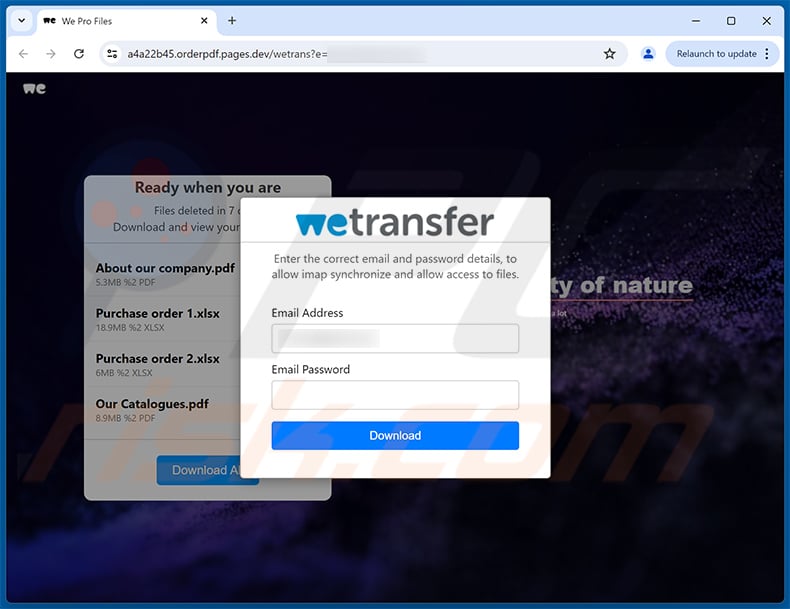
Another example of an email from Quatation Request spam campaign:
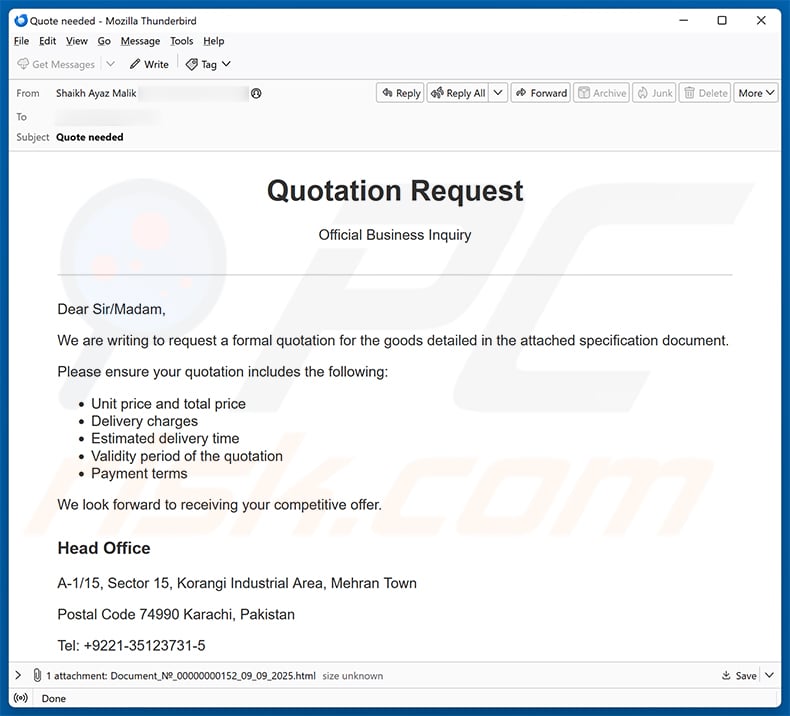
Text presented within:
Subject: Quote needed
Quotation Request
Official Business Inquiry
Dear Sir/Madam,
We are writing to request a formal quotation for the goods detailed in the attached specification document.
Please ensure your quotation includes the following:
Unit price and total price
Delivery charges
Estimated delivery time
Validity period of the quotation
Payment termsWe look forward to receiving your competitive offer.
Head OfficeA-1/15, Sector 15, Korangi Industrial Area, Mehran Town
Postal Code 74990 Karachi, Pakistan
Tel: +9221-35123731-5
Processing & Yarn Dyeing UnitPlot No.52-53,426-427 & 427-D, Kohi Goth, Jam Kunda Road,
Deh Landhi, Bin Qassim Town, Karachi, Pakistan.
Tel: +92-021-38784320
Best Regards,
Shaikh Ayaz Malik
Senior Executive, Marketing
Instant automatic malware removal:
Manual threat removal might be a lengthy and complicated process that requires advanced IT skills. Combo Cleaner is a professional automatic malware removal tool that is recommended to get rid of malware. Download it by clicking the button below:
DOWNLOAD Combo CleanerBy downloading any software listed on this website you agree to our Privacy Policy and Terms of Use. To use full-featured product, you have to purchase a license for Combo Cleaner. 7 days free trial available. Combo Cleaner is owned and operated by RCS LT, the parent company of PCRisk.com.
Quick menu:
- What is "Quotation Request" malspam?
- Types of malicious emails.
- How to spot a malicious email?
- What to do if you fell for an email scam?
Types of malicious emails:
![]() Phishing Emails
Phishing Emails
Most commonly, cybercriminals use deceptive emails to trick Internet users into giving away their sensitive private information, for example, login information for various online services, email accounts, or online banking information.
Such attacks are called phishing. In a phishing attack, cybercriminals usually send an email message with some popular service logo (for example, Microsoft, DHL, Amazon, Netflix), create urgency (wrong shipping address, expired password, etc.), and place a link which they hope their potential victims will click on.
After clicking the link presented in such email message, victims are redirected to a fake website that looks identical or extremely similar to the original one. Victims are then asked to enter their password, credit card details, or some other information that gets stolen by cybercriminals.
![]() Emails with Malicious Attachments
Emails with Malicious Attachments
Another popular attack vector is email spam with malicious attachments that infect users' computers with malware. Malicious attachments usually carry trojans that are capable of stealing passwords, banking information, and other sensitive information.
In such attacks, cybercriminals' main goal is to trick their potential victims into opening an infected email attachment. To achieve this goal, email messages usually talk about recently received invoices, faxes, or voice messages.
If a potential victim falls for the lure and opens the attachment, their computers get infected, and cybercriminals can collect a lot of sensitive information.
While it's a more complicated method to steal personal information (spam filters and antivirus programs usually detect such attempts), if successful, cybercriminals can get a much wider array of data and can collect information for a long period of time.
![]() Sextortion Emails
Sextortion Emails
This is a type of phishing. In this case, users receive an email claiming that a cybercriminal could access the webcam of the potential victim and has a video recording of one's masturbation.
To get rid of the video, victims are asked to pay a ransom (usually using Bitcoin or another cryptocurrency). Nevertheless, all of these claims are false - users who receive such emails should ignore and delete them.
How to spot a malicious email?
While cyber criminals try to make their lure emails look trustworthy, here are some things that you should look for when trying to spot a phishing email:
- Check the sender's ("from") email address: Hover your mouse over the "from" address and check if it's legitimate. For example, if you received an email from Microsoft, be sure to check if the email address is @microsoft.com and not something suspicious like @m1crosoft.com, @microsfot.com, @account-security-noreply.com, etc.
- Check for generic greetings: If the greeting in the email is "Dear user", "Dear @youremail.com", "Dear valued customer", this should raise suspiciousness. Most commonly, companies call you by your name. Lack of this information could signal a phishing attempt.
- Check the links in the email: Hover your mouse over the link presented in the email, if the link that appears seems suspicious, don't click it. For example, if you received an email from Microsoft and the link in the email shows that it will go to firebasestorage.googleapis.com/v0... you shouldn't trust it. It's best not to click any links in the emails but to visit the company website that sent you the email in the first place.
- Don't blindly trust email attachments: Most commonly, legitimate companies will ask you to log in to their website and to view any documents there; if you received an email with an attachment, it's a good idea to scan it with an antivirus application. Infected email attachments are a common attack vector used by cybercriminals.
To minimise the risk of opening phishing and malicious emails we recommend using Combo Cleaner Antivirus for Windows.
Example of a spam email:

What to do if you fell for an email scam?
- If you clicked on a link in a phishing email and entered your password - be sure to change your password as soon as possible. Usually, cybercriminals collect stolen credentials and then sell them to other groups that use them for malicious purposes. If you change your password in a timely manner, there's a chance that criminals won't have enough time to do any damage.
- If you entered your credit card information - contact your bank as soon as possible and explain the situation. There's a good chance that you will need to cancel your compromised credit card and get a new one.
- If you see any signs of identity theft - you should immediately contact the Federal Trade Commission. This institution will collect information about your situation and create a personal recovery plan.
- If you opened a malicious attachment - your computer is probably infected, you should scan it with a reputable antivirus application. For this purpose, we recommend using Combo Cleaner Antivirus for Windows.
- Help other Internet users - report phishing emails to Anti-Phishing Working Group, FBI’s Internet Crime Complaint Center, National Fraud Information Center and U.S. Department of Justice.
Frequently Asked Questions (FAQ)
Why did I receive this email?
Spam emails are not personal, even if they include details relevant to the recipient. Cyber criminals distribute this mail by the thousand with the hopes that at least some recipients will fall for their scams.
I have read a spam email but didn't open the attachment, is my computer infected?
Reading an email is harmless; devices are infected when malicious attachments or links are opened/clicked.
I have downloaded and opened a file attached to a spam email, is my computer infected?
If the opened file was an executable (.exe, .run, etc.) – most likely, yes – the system was infected. However, documents (.doc, .xls, .one, .pdf, etc.) can require additional interaction (e.g., enabling macro commands, clicking embedded content, etc.) to jumpstart malware download/installation chains.
Will Combo Cleaner remove malware infections present in email attachments?
Yes, Combo Cleaner can detect and eliminate most of the known malware infections. Note that since sophisticated malicious software typically hides deep within systems – running a full system scan is paramount.
Share:

Tomas Meskauskas
Expert security researcher, professional malware analyst
I am passionate about computer security and technology. I have an experience of over 10 years working in various companies related to computer technical issue solving and Internet security. I have been working as an author and editor for pcrisk.com since 2010. Follow me on Twitter and LinkedIn to stay informed about the latest online security threats.
PCrisk security portal is brought by a company RCS LT.
Joined forces of security researchers help educate computer users about the latest online security threats. More information about the company RCS LT.
Our malware removal guides are free. However, if you want to support us you can send us a donation.
DonatePCrisk security portal is brought by a company RCS LT.
Joined forces of security researchers help educate computer users about the latest online security threats. More information about the company RCS LT.
Our malware removal guides are free. However, if you want to support us you can send us a donation.
Donate
▼ Show Discussion